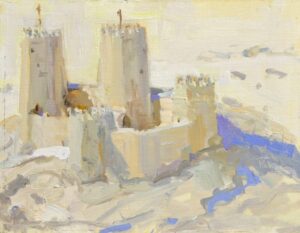Sometimes it seems that painters look for answers anywhere except from where they can most readily find the truth… personal observation. I get loads of emails asking about everything, literally, from what kind of brushes I use to where to eat in Rome. A recent question came in regarding the different colors for painting snow versus those for painting white sand. I love this question! It seems logical and that it should have an easy answer.
The problem is, there are no easy answers. Sure, I could spout all sorts of physics equations and present scientific research on the reflective and refractive indexes of surfaces. Any of you can look online and read the same. (Search Albedo Measurement just for fun.) Of course, what we are really talking about are the differences between snow cones and grits.
Percentage of diffusely reflective sunlight relative to various surface conditions:

Lori Putnam OPA
6″ x 8″
If we are looking at white sand, however, we need to remember that it is comprised of different particles such as silicone dioxide (in the form of granite) and other gems and minerals filled with particles of impurities. The light hitting these tiny grains scatters about, some absorbing more light, others very little, and at differing speeds. The appearance to the novice may be similar to snow, but after much observation it becomes more apparent that one is an opaque surface and the other a translucent one. Just as in any situation, the same theory applies to the shadow color, which is reflected sky and surroundings’ colors, but is now relative to a totally different surface condition.

Lori Putnam OPA
11″ x 14″
Plein air (private collection)
Wait! I just asked you to learn to observe and now I’m asking you to make a decision about those observations. Yep. You’re a big boy/girl now and you get to make your own decisions. You choose what to put in and what not to put in. You choose how chromatic or neutral you want your painting to be. You are in control of the painting, rather than the other way around. This is where science, personal observation, and creativity collide and you are a full-fledged artist. Congratulations.
Here’s my challenge: Find out where you think you are along this path, and be open to growth into the next phase. Never just settle for someone else’s answer; find your own.
A final word: Yellow sand, good; yellow snow, not so good.
Leave a Reply